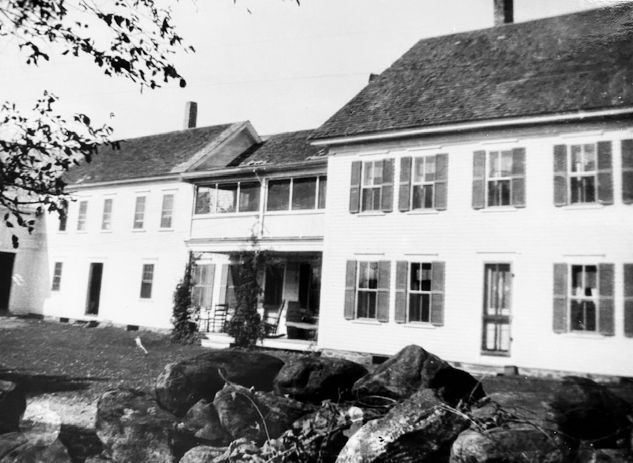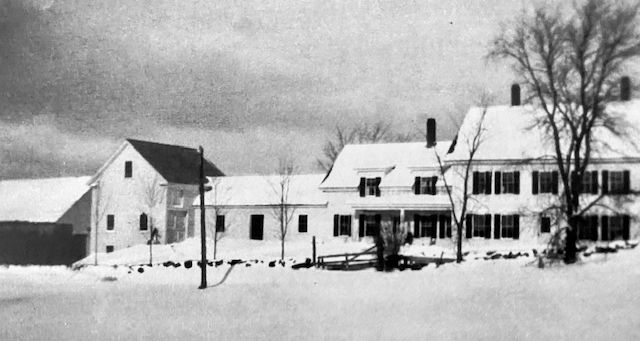New Boston Historical Society
New Boston, New Hampshire

The Colburn Homestead after 1917 additions - photo courtesy of Bonnie Champagne
Behind the Door: 280 Colburn Road — the Colburn Homestead
by Mary Atai (January 2021)
Prior to the stewardship of the Noonans, there is a 200-year history of ownership by the Colburn family.
The story of the land began with Major John Burns, son of John Burns, one of the original New Boston inhabitants. Major Burns married the widow of William McMaster, who had settled on this very land. They lived on his new wife's land for a time and then the family sold the farm to David Colburn from Dedham, Massachusetts in 1795. This land became the basis of the Colburn Homestead.
David Colburn and his wife, Rebecca, traveled from Dedham to the farm on horseback to take possession, and brought with them scions with which they started the first orchard of grafted apple trees in New Boston. Their house burned down in 1810 and a new house was built.
One of David's sons, Ephraim, married Rachel Newell and they had seven sons. The third son, Luther, became the third generation of Colburns on the Homestead. This was a productive time. A sawmill had been built on the brook coming from Scobie Pond. There were two dams. Until the 1950s, the cast iron water wheels and the cast-iron counter balanced wheel, to which the vertical saw was connected, lay in the bed of the brook. These were removed by Edward Colburn and his son, Robert. Most of the surrounding houses were built with timber sawed at this mill.
After his first wife's death, Luther married Hannah Eastman Story of Goffstown. In 1860, the farm had 170 acres of improved land and 50 acres of unimproved land, 4 horses, 13 milk cows, 2 oxen, 28 other cattle, and 7 hogs. Besides all the produce that year, the farm provided 1500 pounds of butter, 1200 pounds of cheese, 75 tons of hay, 25 bushels of wheat, and a successful orchard.
Luther died at only 56. Widow Hannah oversaw the building of a new house in 1870 to replace 2 smaller houses used at the time. This house was built by Ephraim Warren Colburn, who had also built the sawmill.
Hannah developed a successful business in boiled cider and cider applesauce in the old cider mill on the property. This became one of the principal sources of income for the next 25 years. In a good year, the farm produced about 200 barrels of apples, mostly Baldwins.
When Charles Story Colburn (youngest son of Luther and Hannah) took over the farm, he added three 30-foot hen houses, an addition on the old cider mill, an icehouse and new barns. Unfortunately, though, a chimney fire caused the main house to burn down in 1904.

After the fire, this house was rebuilt in 1904. This is before the additions of 1917.
In the spring of 1917, a second story was built over the woodshed, making an apartment for Charles, when he could no longer farm. His son, Edward Newell Colburn and his wife, Nina carried on after Charles died in 1920. Electricity came to the farm in 1937.
Edward Newell Colburn deeded the farm to his son, Robert, in 1970. Robert and his wife, Olive St. John Colburn operated it as a dairy farm. Olive converted the old horse barn into a Christmas gift shop and the 22-room house was a bed and breakfast for a time. After Robert passed away, Olive later sold the farm out of the Colburn family, ending the run of the longest held family farm in New Boston.
The author thanks Edward N. Colburn, Roger Noonan, and Bonnie Champagne
Click here to return to the main page for "Behind the Door" articles.
